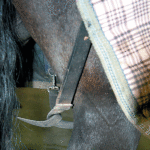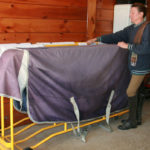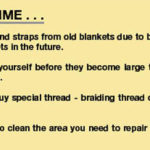In a nutshell, skip blanketing if you can. A horse who has never been blanketed probably won’t need to be, unless you decide to clip him or he’s too old to continue to fight the weather. Woolly coats insulate horses from the cold air. Wind and wet are separate issues, however, so shelter or blankets must be provided in these conditions.
When you must blanket your horse — whether due to weather, a body clip, horrible fly season or to keep him clean during a show — let common sense prevail. If your horse is shivering in the cold, he probably needs a heavier — or double — blanket. And if he’s sweating under his stable or fly sheet, remove it. Like people, horses have individual tolerances for the environment. Our chart on page 17 is a guide.
If your horse is alone all day with no one to switch blankets when the weather changes, you must consider the likelihood of the day’s weather. Always underblanket rather than overblanket. A horse who sweats under his blanket during the afternoon sun, but then experiences the nippy cold that sets in as soon as the sun sets at 5 p.m., can quickly become ill. (For this reason, we lean toward waterproof-breathable turnouts whenever possible.)
Don’t forget the wind factor: In hot weather, a wind can cool by evaporation. When it’s cold, the wind creates a chill factor.
Adjust for the season with turnout blankets. When it’s fly season, substitute a fly sheet when possible. When it’s rainy, use a waterproof-breathable rain sheet. In snow, use a waterproof-breathable winter turnout.
If you use a blanket with removable leg straps, keep a spare set on hand to replace those that break or get hopelessly stained/dirty and to use while washing the first set.
Cleanliness
A blanketed horse should always be clean and dry. Horses have a knack for getting stains on their coats and legs in weather when you would rather not bath them. For manure and urine stains that are still wet, try club soda or a mixture of club soda and vinegar. Rinse the area liberally and blot/rub with a towel and dry.
Dried stains are more difficult. Peroxide or diluted Clorox work on white areas but are tough on the skin and might change hair color (especially bargain bleaches, which can yellow). Try a paste made of two parts Ivory Snow and one part Snowy bleach (use the brand names), vinegar and baking soda or cream of tartar and lemon juice. Toothpaste on a brush works great too but is tedious and harder to remove.
Blanket Cleanliness
You wouldn’t dream of using the same saddle pad for months without washing it, but many horses go through the winter wearing the same blanket (which is why we suggest a you have a spare of each). In addition to plain old dirt, blanket fibers become home to irritating chemicals from urine, bacteria and fungi from manure and the environment, plus dead skin cells and skin secretions from the horse.
Any one or more of these is all in a day’s work for the immune system protecting your horse’s skin. However, when you also add a thick winter coat, less frequent grooming and decreased exposure of the skin to fresh air and sunlight, problems can develop.
Stiff, heavy blankets cause physical irritation that can set the stage for skin infections. Dermatophilus (rain rot) and a variety of potential bacterial or fungal infections may be lurking under there. Help prevent these by using blankets only when necessary, exposing the skin to the air and sunlight as often as possible. Regular deep grooming with brushes and a curry that reaches down to skin level both help maintain healthy skin and allow you to detect any problem areas early.
Keep around a supply of lightweight stable sheets, even the tattered and not quite presentable ones you might normally throw out, to use under heavy blankets as liners. These can be laundered frequently at home so that the horse always has a clean fabric against his body.
Spot Cleaning
Ever find a urine or manure stain on a blanket or wraps you need to use for shipping that day’ No time for washing’ Try foam carpet or upholstery cleaner. Remove all surface debris, spray on cleaner, allow to work for the recommended time then rub off stain and foam. Stubborn stains may need a second application and/or use of a brush before sponging clean.
Also With This Article
Click here to view ”Moving From South To North.”
Click here to view ”Related Articles And Top Choices.”
Click here to view ”Blanketing Recommendations.”







